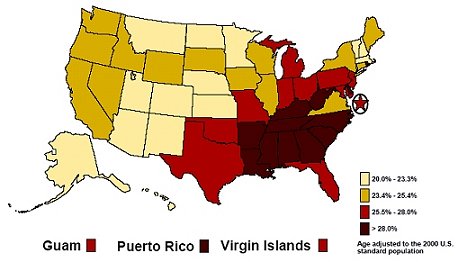 |
|
 |
 |
 |
Fact Sheets and At–a–Glance Reports
High Blood Pressure Fact Sheet
This document is also available in Portable
Document Format (PDF - 85K).
Learn more about
PDFs.
Percent of persons who were ever told they had high
blood pressure,
Adults aged 20 years and older, 2003.

Source: CDC, Behavioral Risk Factor Surveillance System.
[A text
version of this graphic is also available.]
Facts on High Blood Pressure
- High blood pressure (hypertension) killed 49,707 Americans in 2002. Because the
consequences associated with high blood pressure are so serious, early
detection, treatment, and control are important.
- High blood pressure
increases the risk for heart disease and stroke, both leading causes of
death in the United States. About 1 in 3 American adults have high blood
pressure. High blood pressure affects about 2 in 5 African Americans, 1
in 5 Hispanics and Native Americans, and 1 in 6 Asians.
- What do blood pressure
numbers indicate? Blood pressure is often written as two numbers. The top
(systolic) number represents the pressure while the heart is beating.
The bottom (diastolic) number represents the pressure when the heart is
resting between beats.
- High blood pressure
for adults is defined as a systolic pressure of 140 mmHg or higher, or a
diastolic pressure of 90 mmHg or higher.
- Normal blood pressure is a systolic blood pressure less than
120 and a diastolic blood pressure less than 80.
- Prehypertension is defined as a systolic blood pressure of
120–139 mmHg or a diastolic blood pressure of 80–89 mmHg. Persons with
prehypertension are at increased risk to progress to hypertension.
- Among people with high blood pressure, 31.6% don't even know they have it.
- High blood pressure is
easily detectable and usually controllable with lifestyle modifications
such as increasing physical activity or reducing dietary salt intake,
with or without medications.
- The Joint National Committee on Prevention, Detection,
Evaluation, and Treatment of High Blood Pressure (JNC-7) recommends
that adults have their blood pressure checked regularly.
Statistics from CDC's National Center for Health
Statistics as published by the American Heart Association, Heart Disease and
Stroke Statistics-2005 Update. Dallas, TX: AHA, 2004. http://www.americanheart.org.*
CDC's Public Health Efforts
CDC currently funds
health departments in 32 states and the District of Columbia to develop
effective strategies to reduce the burden of cardiovascular diseases and
related risk factors with an overarching emphasis on heart healthy
policies and physical and social environmental changes. Through these
state programs, CDC aims to reduce disparities in treatment, risk
factors, and disease; delay the onset of disease; postpone death from
cardiovascular disease; and reduce disabling conditions. For more
information on CDC's Cardiovascular Health State Program, please visit our
Web site at http://www.cdc.gov/cvh/state_program/index.htm
For More Information
For more information
about high blood pressure, visit the Web sites of the
following CDC partners:
Return to Top of Page
*Links to non–Federal organizations are provided solely as a service to our users. Links do not constitute an endorsement of any organization by CDC or the Federal Government, and none should be inferred. The CDC is not responsible for the content of the individual organization Web pages found at this link.
Date last reviewed:
05/12/2006
Content source: Division for Heart Disease and Stroke
Prevention,
National Center for Chronic Disease Prevention and
Health Promotion |
 |